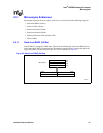
Hardware Reference Manual 179
Intel
®
IXP2800 Network Processor
Microengines
The CAM can be cleared with CAM_Clear instruction. This instruction writes 0x00000000
simultaneously to all entries tag, clears all the state bits, and puts the LRU into an initial state
(where entry 0 is LRU, ..., entry 15 is MRU).
4.4 CRC Unit
The CRC Unit operates in parallel with the Execution Datapath. It takes two operands, performs a
CRC operation, and writes back a result. CRC-CCITT, CRC-32, CRC-10, CRC-5, and iSCSI
polynomials are supported. One of the operands is the CRC_Remainder Local CSR, and the other
is a GPR, Transfer_In register, Next Neighbor, or Local Memory, specified in the instruction and
passed through the Execution Datapath to the CRC Unit. The instruction specifies the CRC
operation type, whether to swap bytes and or bits, and the bytes of the operand to be included in the
operation. The result of the CRC operation is written back into CRC_Remainder. The source
operand can also be written into a destination register (however the byte/bit swapping and masking
do not affect the destination register; they only affect the CRC computation). This allows moving
data, for example, from S_TRANSFER_IN registers to S_TRANSFER_OUT registers at the same
time as computing the CRC.
Example 26. Algorithm for Debug Software to Determine the Contents of the CAM
; First read each of the tag entries. Note that these reads
; don’t modify the LRU list or any other CAM state.
tag[0] = CAM_Read_Tag(entry_0);
......
tag[15] = CAM_Read_Tag(entry_15);
; Now read each of the state bits
state[0] = CAM_Read_State(entry_0);
...
state[15] = CAM_Read_State(entry_15);
; Knowing what tags are in the CAM makes it possible to
; create a value that is not in any tag, and will therefore
; miss on a lookup.
; Next loop through a sequence of 16 lookups, each of which will
; miss, to obtain the LRU values of the CAM.
for (i = 0; i < 16; i++)
BEGIN_LOOP
; Do a lookup with a tag not present in the CAM. On a
; miss, the LRU entry will be returned. Since this lookup
; missed the LRU state is not modified.
LRU[i] = CAM_Lookup(some_tag_not_in_cam);
; Now do a lookup using the tag of the LRU entry. This
; lookup will hit, which makes that entry MRU.
; This is necessary to allow the next lookup miss to
; see the next LRU entry.
junk = CAM_Lookup(tag[LRU[i]]);
END_LOOP
; Because all entries were hit in the same order as they were
; LRU, the LRU list is now back to where it started before the
; loop executed.
; LRU[0] through LRU[15] holds the LRU list.


















